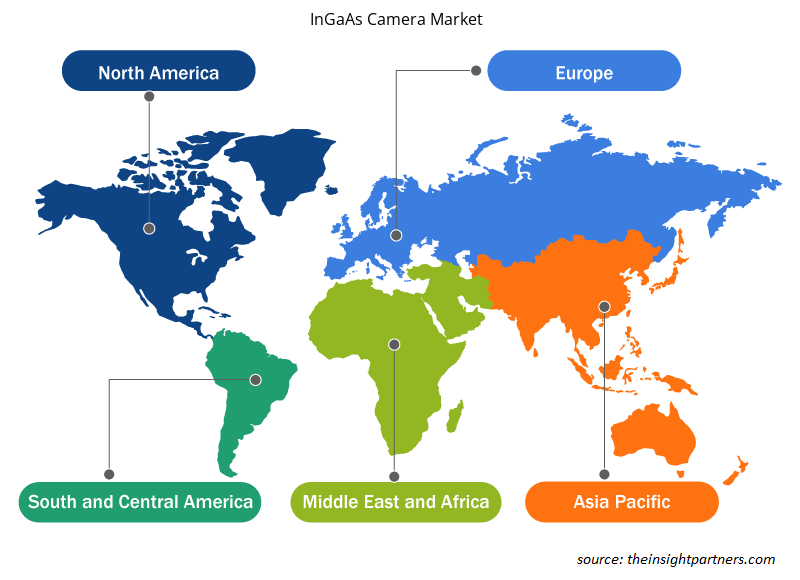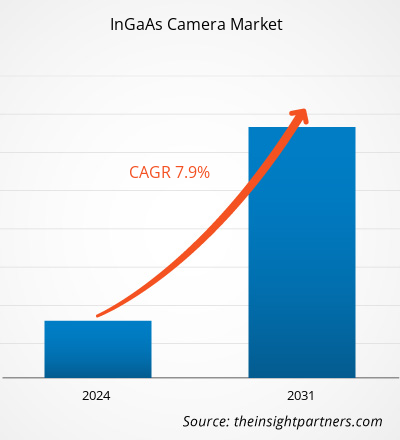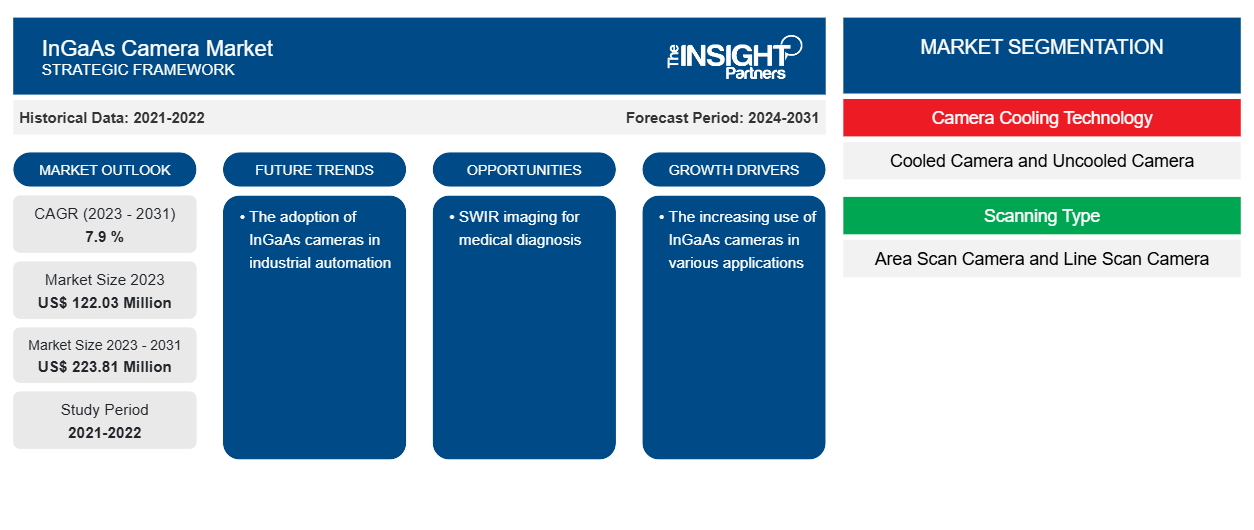InGaAs 相机市场规模预计将从 2023 年的 1.2203 亿美元增至 2031 年的 2.2381 亿美元。预计 2023-2031 年期间该市场的复合年增长率将达到 7.9%。工业自动化中采用 InGaAs 相机可能仍是市场的主要趋势。
InGaAs相机市场分析
InGaAs 相机市场的增长归因于这些相机在各种应用中的使用增加,例如工业自动化和医疗诊断。 SWIR 相机可以防止这种情况,从而确保生产过程顺利进行。 因此,在各种应用中增加 InGaAs 相机的使用正在推动 InGaAs 相机市场的发展。 还讨论了 SWIR 成像技术,例如用于生物医学应用的 SWIR 高光谱成像和基于新型量子点 (QD) 图像传感器的宽带 (VIS+SWIR) 数字全息显微系统。 因此,在各种应用中增加 InGaAs 相机的使用正在推动市场的发展。
InGaAs 相机市场概览
InGaAs 传感器用于物理和生命科学领域,需要在 900-1700 nm 波长范围内(称为短波红外 (SWIR))具有高灵敏度。由于材料成分的变化,一些 InGaAs 传感器可以测量高达 2500 nm 的波长。尽管硅基 CCD 相机在 UV 到 NIR 范围内具有灵敏度,但硅的带隙特性使这些 CCD 在 1100 nm 以上不具有足够的灵敏度。InGaAs 相机具有较低的带隙,使这种材料成为短波红外 (SWIR) 区域应用的首选材料。
定制此报告以满足您的需求
您可以免费定制任何报告,包括本报告的部分内容、国家级分析、Excel 数据包,以及为初创企业和大学提供优惠和折扣
-
获取此报告的关键市场趋势。这个免费样品将包括数据分析,从市场趋势到估计和预测。
InGaAs 相机市场驱动因素和机遇
InGaAs 相机在各种应用中的使用日益广泛
检查硅晶体和硅锭(也称为硅块)是半导体领域 InGaAs 相机最受欢迎的应用之一。能够以高于 1,150 nm 的波长范围观察硅,这为 InGaAs 相机提供了一种合适的解决方案,用于检测夹杂物,例如晶体或硅锭中的杂质,这些杂质可能在生产过程中聚集。在使用金刚石链条观察硅锭的薄晶圆时,杂质至关重要。如果链条碰到某种元素,例如一小块金属,那么非常昂贵的链条就会断裂。更换链条不仅会产生成本,还会导致生产率下降和利润减少。SWIR 相机可以防止这种情况发生,从而确保生产过程顺利进行。因此,在各种应用中增加 InGaAs 相机的使用正在推动 InGaAs 相机市场的发展。
SWIR 成像用于医学诊断
SWIR 成像用于医学诊断。基于 SWIR 光的开发技术包括 SWIR 纳米粒子作为光热剂和发光纳米温度计的制造和使用,以及稀土掺杂纳米粒子 (REDN) 的结构、设计和 SWIR 相关生物医学应用的最新进展。REDN 是亮度最高且生物相容性的 SWIR 发射器之一。还讨论了 SWIR 成像技术,例如用于生物医学应用的 SWIR 高光谱成像和基于新型量子点 (QD) 图像传感器的宽带 (VIS+SWIR)数字全息显微系统。因此,在各种应用中增加 InGaAs 相机的使用正在推动市场的发展。
InGaAs 相机市场报告细分分析
有助于得出 InGaAs 相机市场分析的关键部分是相机冷却技术、扫描类型和应用。
- 根据相机冷却技术,InGaAs 相机市场分为冷却相机和非冷却相机。软件部分在 2023 年占据了更大的市场份额。
- 根据扫描类型,市场分为区域扫描相机和线扫描相机。
- 根据应用,市场分为军事和国防、工业自动化和科学研究。
InGaAs 相机市场份额(按地区)分析
InGaAs相机市场报告的地理范围主要分为五个区域:北美、亚太、欧洲、中东和非洲、南美和中美。
亚太地区在 InGaAs 相机市场占据主导地位。工业自动化、无损检测和机器视觉应用日益普及的需求预计将在预测期内推动 InGaAs 相机市场的增长。
InGaAs 相机市场区域洞察
Insight Partners 的分析师已详尽解释了预测期内影响 InGaAs 相机市场的区域趋势和因素。本节还讨论了北美、欧洲、亚太地区、中东和非洲以及南美和中美洲的 InGaAs 相机市场细分和地理位置。

- 获取 InGaAs 相机市场的区域特定数据
InGaAs 相机市场报告范围
| 报告属性 | 细节 |
|---|---|
| 2023 年的市场规模 | 1.2203亿美元 |
| 2031 年市场规模 | 2.2381亿美元 |
| 全球复合年增长率(2023 - 2031) | 7.9% |
| 史料 | 2021-2022 |
| 预测期 | 2024-2031 |
| 涵盖的领域 |
通过相机冷却技术
|
| 覆盖地区和国家 |
北美
|
| 市场领导者和主要公司简介 |
|
市场参与者密度:了解其对商业动态的影响
InGaAs 相机市场正在快速增长,这得益于终端用户需求的不断增长,这些需求源于消费者偏好的不断变化、技术进步以及对产品优势的认识不断提高等因素。随着需求的增加,企业正在扩大其产品范围,进行创新以满足消费者的需求,并利用新兴趋势,从而进一步推动市场增长。
市场参与者密度是指在特定市场或行业内运营的企业或公司的分布情况。它表明在给定市场空间中,相对于其规模或总市场价值,有多少竞争对手(市场参与者)存在。
在 InGaAs 相机市场运营的主要公司有:
- 滨松光子学株式会社
- 联合视觉技术有限公司
- 新的成像技术
- 彭布罗克仪器有限公司
- 保利泰克有限公司
- 猛禽光子学有限公司
免责声明:上面列出的公司没有按照任何特定顺序排列。

- 获取 InGaAs 相机市场顶级关键参与者概览
InGaAs 相机市场新闻和最新发展
InGaAs 相机市场通过收集一手和二手研究后的定性和定量数据进行评估,其中包括重要的公司出版物、协会数据和数据库。以下列出了 InGaAs 相机市场的一些发展情况:
- 领先的尖端光子学技术和产品供应商滨松光子学公司推出了一款新型 InGaAs 相机,其灵敏度在 400 nm 至 1700 nm 的可见光至近红外区域内。(来源:滨松光子学公司,新闻稿,2024 年 2 月。)
- 日本 BlueVision Ltd. 于 2021 年 4 月推出了一款名为 BV-C3110 的新型 1K SWIR 线扫描相机,这是一款全新的 1K InGaAs 传感器(来源:BlueVision Ltd,新闻稿,2021 年 4 月)
InGaAs 相机市场报告覆盖范围和交付成果
“InGaAs 相机市场规模和预测(2021-2031 年)”报告对以下领域进行了详细的市场分析:
- InGaAs 相机市场规模以及全球、区域和国家层面所有主要细分市场的预测
- InGaAs 相机市场趋势,以及驱动因素、限制因素和关键机遇等市场动态
- 详细的 PEST/波特五力分析和 SWOT 分析
- InGaAs 相机市场分析涵盖主要市场趋势、全球和区域框架、主要参与者、法规和最新市场发展
- 行业格局和竞争分析,涵盖市场集中度、热图分析、知名企业以及 InGaAs 相机市场的最新发展
- 详细的公司简介
- 历史分析(2 年)、基准年、预测(7 年)及复合年增长率
- PEST和SWOT分析
- 市场规模、价值/数量 - 全球、区域、国家
- 行业和竞争格局
- Excel 数据集
近期报告
相关报告
客户评价
购买理由
- 明智的决策
- 了解市场动态
- 竞争分析
- 客户洞察
- 市场预测
- 风险规避
- 战略规划
- 投资论证
- 识别新兴市场
- 优化营销策略
- 提升运营效率
- 顺应监管趋势























 获取免费样品 - InGaAs相机市场
获取免费样品 - InGaAs相机市场